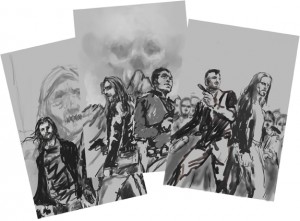There is a lot of science fiction and fantasy art about these days. From science fiction book covers to magazines, box art for games, digital art for video games, album covers, even body art. All of these surfaces display images depicting science fiction or fantasy subjects.
So how does it get there? Obviously it gets chosen. Either the purveyor of the aforementioned media buys a ready made image, or he or she will commission one from an artist. In a perfect world the artist supplies the art, is paid a suitable recompense for his or her time and effort, and the art is reproduced and distributed. Easy, right?
Well, not always.
 The art you see on these products doesn’t just happen overnight. Once an artist is tapped to produce an image the artist will produce countless thumbnail sketches. Out of these he or she will produce a few more finished sketches to get the concept across. One of the concepts will be chosen either by the one paying for the art or an art director depending on where it is being sold to. The artist will create a finished version of the chosen concept and it may be approved or sent back for changes.
The art you see on these products doesn’t just happen overnight. Once an artist is tapped to produce an image the artist will produce countless thumbnail sketches. Out of these he or she will produce a few more finished sketches to get the concept across. One of the concepts will be chosen either by the one paying for the art or an art director depending on where it is being sold to. The artist will create a finished version of the chosen concept and it may be approved or sent back for changes.
At the end of this exhaustive process, the art is finalized and is prepared for printing. It is a lot of work for both the artist and for the one commissioning the art. Artist and publisher, usually represented by an art director, work together to create a work that is suitable and appropriate for the final product. But what happens if at some point in this process one of the parties changes his or her mind?
When you are making commercial art you can’t forget the term “commercial”. It is business. If the one commissioning the art changes his or her mind at any point in the process it’s usually for business reason. Sometimes those reasons are solid and practical but sometimes they can seem capricious, especially to the artist who has put much time and effort… who has poured his or her heart and soul… into the work.
It happens. It has happened to me a few times. As an artist you need to understand that this is business, that you are merely one part of a final product and if your work is not in line or consistent with the needs of the product, then it has to be rejected.
When this happens an artist is usually paid for his time and efforts. Sometimes they aren’t and that can lead to a litigation and all sorts of ugliness. Usually, though, artists are compensated and in business terms that’s good.
In artistic terms it can feel like a personal rejection. There is a great temptation to take it personally. Was I not good enough? What’s wrong with my work? Was it something I said? I should have worked harder. There is also a temptation to get angry. They don’t recognize great art! They wouldn’t know good work if it bit them on the bum!
Here is a good example of how to handle this situation. Greg Manchess has been an illustrator for more than 30 years. His paintings have appeared on the covers of Time, National Geographic, and Atlantic Monthly, among others. But even his work sometimes doesn’t make the cut.
Here is a piece he was commissioned by Tor books to paint for a cover for a modern update on the Tarzan legend that focuses on Jane. Greg went through the process I described above. The art was finished and it met the approval of the art director as well as the estate of Edgar Rice Burroughs.
Tor Books’ marketing department, however, wanted something different. They wanted a more contemporary look to match the contemporary attitude of the book. They decided to go in a different direction. Another artist was hired and that cover was chosen for the book.
Manchess’s attitude? As he puts it; “Despite the great time I had working on it, and my desire to see it published, I saw their point. These things happen.”
Was Manchess angry? Hurt? Probably. The artist they chose to do the cover was a good friend of Manchess’s, which may have taken the sting out of it or made it bittersweet. But Manchess’s attitude about that is exemplary. “Ultimately, I was glad a friend and great artist got this one. Sometimes, ya just gotta let stuff go. There will be more opportunities down the road.”
This is a business. Art is personal. The best art is an expression of the artist’s heart and soul. To have one’s heart and soul passed over for another can be a devastating thing. But as a working artist, you develop a thick skin. You have to be philosophical about it and accept the situation with as much grace as Manchess did.
Then move on to your next piece. Because that one is going to be even better!
M. D. Jackson has been drawing since he could first hold a pencil. He has been writing for so long that he has, in fact, developed an alternate personality named Jack to handle the fiction.
His work has appeared in numerous magazines and on the front covers of many books as well as in the pages of Amazing Stories Magazine. You can also see a lot of it at his gallery.











